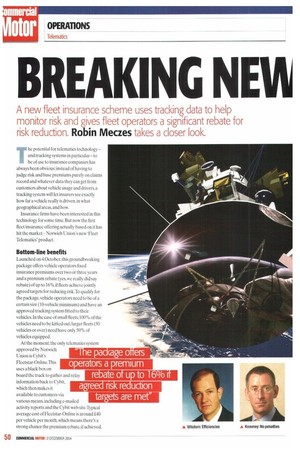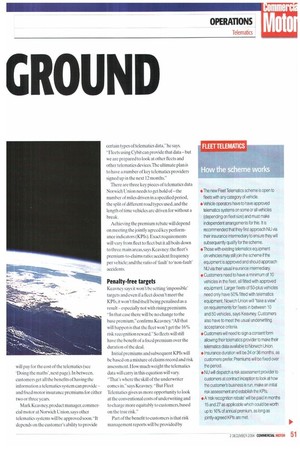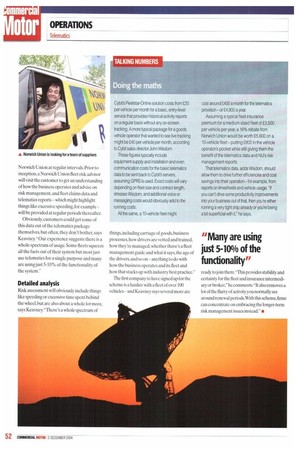BREAK NG NEVii GROUND
Page 50

Page 51

Page 52

If you've noticed an error in this article please click here to report it so we can fix it.
A new fleet insurance scheme uses tracking data to help monitor risk and gives fleet operators a significant rebate for risk reduction. Robin Meczes takes a closer look.
The potential for telematics technology — and tracking systems in particular — to be of use to insurance companies has always been obvious: instead of having to judge risk and base premiums purely on claims record and whatever data they can get from customers about vehicle usage and drivers, a tracking system will let insurers see exactly how far a vehicle really is driven, in what geographical areas, and how.
Insurance firms have been interested in this technology for some time. But now the first fleet insurance offering actually based on it has hit the market— Norwich Union's new 'Fleet Telematics' product.
Bottom-line benefits
Launched on 4 October, this groundbreaking package offers vehicle operators fixed insurance premiums over two or three years and a premium rebate (yes, we really did say rebate) of up to 16% if fleets achieve jointly agreed targets for reducing risk.To qualify for the package, vehicle operators need to be of a certain size (10-vehicle minimum) and have an approved tracking system fitted to their vehicles. In the case of small fleets,100% of the vehicles need to be kilted out; larger fleets (50 vehicles or over) need have only 50% of vehicles equipped.
At the moment, the only telernatics system approved by Norwich Union is Cybit's Fleetstar-Online.This uses a black box on board the truck to gather and relay information back to Cybit, which then makes it available to customers via various means, including e-mailed activity reports and the ybit web site.Typical average cost of Fleetstar-Online is around £40 per vehicle per month, which means there's a strong chance the premium rebate, if achieved, will pay for the cost of the telematics (see 'Doing the maths',next page). In between, customers get all the benefits of having the information a telematics system can provide and fixed motor insurance premiums for either two or three years.
Mark Keavney product manager,conunercial motor at Norwich Union. says other telematics systems will be approved soon. "It depends on the customer's ability to provide certain types of telematics data," he says. "Fleets using Cybit can provide that data -but we are prepared to look at other fleets and other telematics devices.The ultimate plan is to have a number of key telematics providers signed up in the next 12 months."
There are three key pieces of telematics data Norwich Union needs to get hold ofthe number of miles driven in a specified period, the split of different road types used, and the length of time vehicles are driven for without a break.
Achieving the premium rebate will depend on meeting the jointly agreed key performance indicators (KPIs). Exact requirements will vary from fleet to fleet but it all boils down to three main areas, says Keavney: the fleet's premium-to-claims ratio; accident frequency per vehicle; and the ratio of 'fault' to 'non-fault' accidents.
Penalty-free targets
Keavney says it won't be settingimpossible' targets and even if a fleet doesn't meet the KPIs, it won't find itself being penalised as a result especially not with rising premiums. "In that case there will be no change to the base premium," confirms Keavney. All that will happen is that the fleet won't get the 16% risk recognition reward." So fleets will still have the benefit of a fixed premium over the duration of the deal.
Initial premiums and subsequent KPIs will be based on a mixture of claims record and risk assessment. How much weight the telematics data will carry in this equation will vary "That's where the skill of the underwriter comes in,says Keavney. "But Fleet Telematics gives us more opportunity to look at the conventional costs of underwriting and to charge more equitably to customers, based on the true risk."
Part of the benefit to customers is that risk management reports will be provided by Norwich Union at regular intervals. Prior to inception, a Norwich Union fleet risk advisor will visit the customer to get an understanding of how the business operates and advise on risk management, and fleet claims data and telematics reports which might highlight things like excessive speeding, for example will be provided at regular periods thereafter.
Obviously, customers could get some of this data out of the telematics package themselves, but often, they don't bother, says Keavney. "Our experience suggests there is a whole spectrum of usage. Some fleets squeeze all the facts out of their system but most just use telematics for a single purpose and many are using just 5-10% of the functionality of the system."
Detailed analysis
Risk assessment will obviously include things like speeding or excessive time spent behind the wheel, but are also about a whole lot more, says Keavney. "There's a whole spectrum of things, including carriage of goods, business processes, how drivers are vetted and trained, how they're managed, whether there's a fleet management guide and what it says, the age of the drivers, and so on anything to do with how the business operates and its fleet and how that stacks up with industry best practice."
The first company to have signed up for the scheme is a haulier with a fleet of over 100 vehiclesand Keavney says several more are ready to join them. -This provides stability and certainty for the fleet and insurance intermediary or broker," he comments."It also removes a lot of the flurry of activity you normally see around renewal periods. With this scheme, firms can concentrate on embracing the longer-term risk management issues instead.-•




















































































































































































